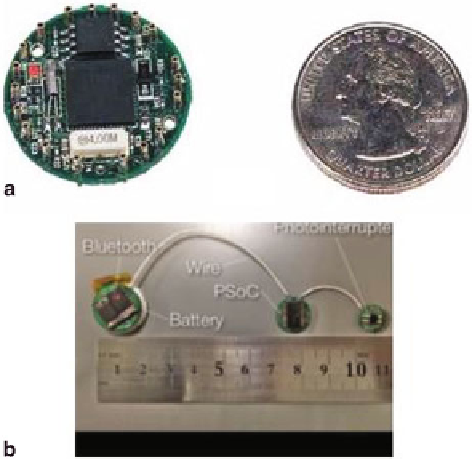Biomedical Engineering Reference
In-Depth Information
Fig. 2 a
MICA2DOT
sensor platform [
16
].
b
Bluetooth-based pulse wave
monitoring system [
20
]
Fig.
2
a provides a full sensor implementation on a small sensor platform. However,
the power consumption of the transmitter is considerably high compared to that
of the Microsemi NB system. An implementation of a small wearable pulse wave
monitoring system that uses a Bluetooth-based transceiver is presented in Fig.
2
b[
20
].
The total current consumption of the systems is estimated to be 51 mA, inclusive of
the current consumption of the Bluetooth transceiver which is estimated to be 21 mA
with an operating voltage of 3.3 V. The comparison in Table
2
shows that the sensor
systems based on the UWB transmitters perform better than the NB-based systems
in terms of power consumption, form factor, and data rate.
The main drawback of the UWB technology is its receiver complexity. Due to
the short pulse width and low-power level of the transmitted signal, the front-end
circuitry of a UWB receiver is complex in design and has high power consumption.
Synchronization of the IR-UWB (impulse radio UWB) pulses at receive stage using
low-power front-end circuitry and controller devices is one of the major problems
that restricts the use of UWB receivers for implant applications. For example, an
analog-to-digital converter (ADC) to be used in a UWB receiver requires a large input
bandwidth and a high sampling rate. ADC12D1800 [
21
] by National Semiconductor
has 3.5 Giga samples per second (Gsps) sampling rate and an input bandwidth of
1.75 GHz, meeting the requirement of digitization at UWB receivers, and consumes
4.4 W of power which is not suitable for battery-powered WBAN sensor design.
It is possible to overcome this drawback either by using a transmitter-only method
or by using a less complex NB wireless technology for the receiver. This chapter
focuses on the implementation of the UWB sensor nodes using these two methods.
This chapter investigates the implementation UWB-based wireless sensor nodes for
WBAN applications. Different design methodologies reported in the literature for

Search WWH ::

Custom Search